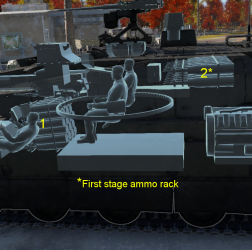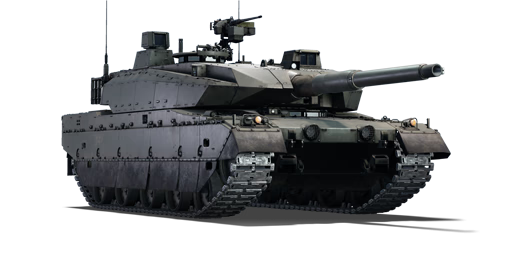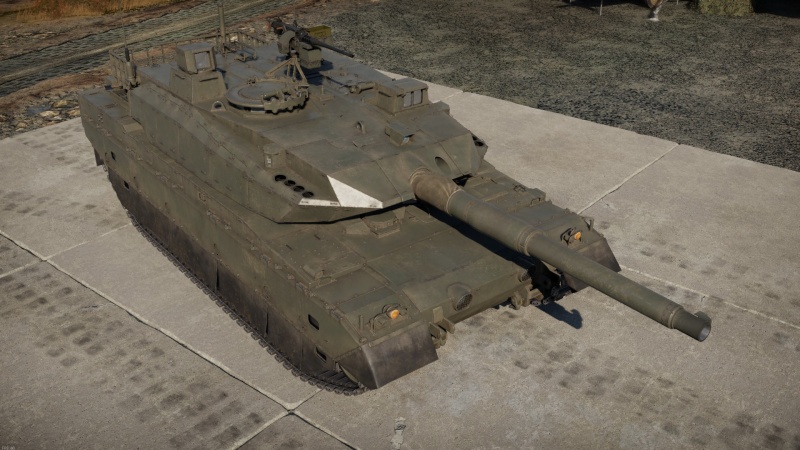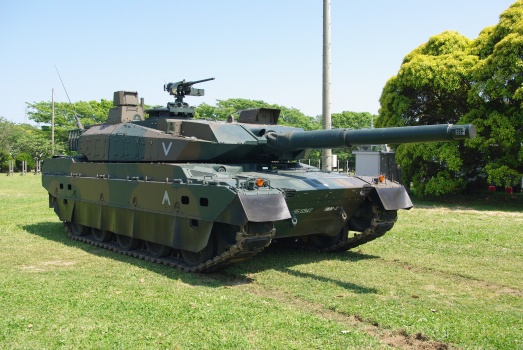Difference between revisions of "TKX"
m |
m (→Description) |
||
| Line 11: | Line 11: | ||
== Description == | == Description == | ||
<!-- ''In the description, the first part should be about the history of the creation and combat usage of the vehicle, as well as its key features. In the second part, tell the reader about the ground vehicle in the game. Insert a screenshot of the vehicle, so that if the novice player does not remember the vehicle by name, he will immediately understand what kind of vehicle the article is talking about.'' --> | <!-- ''In the description, the first part should be about the history of the creation and combat usage of the vehicle, as well as its key features. In the second part, tell the reader about the ground vehicle in the game. Insert a screenshot of the vehicle, so that if the novice player does not remember the vehicle by name, he will immediately understand what kind of vehicle the article is talking about.'' --> | ||
| − | The '''{{Specs|name}}''', more precisely the '''TKX-2-0005''' | + | The '''{{Specs|name}}''', more precisely the '''{{Annotation|TKX-2-0005|New Tank Program 5 - Batch 2 - Tank 3}},''' is the 3rd prototype towards the [[Type 10]]. It was developed soon after the [[Type 90 (Family)|Type 90]] to supplement and replace the ageing [[Type 74 (Family)|Type 74s]] and [[Type 90 (Family)|Type 90s]]. The TKX was designed between 2002 to 2009 until it was adopted in service in 2010 as the [[Type 10]]. Its primary function was to be lighter than the [[Type 90]] with equally effective armour, to access most Japanese infrastructure without hitting the weight limit, and a bigger emphasis on {{Annotation|C4I|command, control, communication, computer & intelligence}} which couldn't properly be fitted into the [[Type 74 (Family)|Type 74s]] and [[Type 90 (Family)|Type 90s]]. |
It was introduced in [[Update "Fire and Ice"]]. Providing the same great firepower as that of the [[Type 90 (Family)|Type 90 MBT]], its armour and mobility will be slightly different. Being a lighter vehicle, the armour is packaged more densely but with similar effectiveness, and the engine has been downgraded to save on weight. But the major selling point the TKX and Type 10 have over their bigger and older brother Type 90 is the new Type 10 APFSDS shell, which will far outshine the JM33/DM33 shell and compete with the end-tier shells of other countries. The TKX also has the additional benefit over the Type 10 of mounting a dozer blade once unlocked. | It was introduced in [[Update "Fire and Ice"]]. Providing the same great firepower as that of the [[Type 90 (Family)|Type 90 MBT]], its armour and mobility will be slightly different. Being a lighter vehicle, the armour is packaged more densely but with similar effectiveness, and the engine has been downgraded to save on weight. But the major selling point the TKX and Type 10 have over their bigger and older brother Type 90 is the new Type 10 APFSDS shell, which will far outshine the JM33/DM33 shell and compete with the end-tier shells of other countries. The TKX also has the additional benefit over the Type 10 of mounting a dozer blade once unlocked. | ||
Revision as of 10:55, 6 February 2024
| This page is about the Japanese medium tank TKX. For other versions, see Type 10 (Family). |
Contents
Description
The TKX, more precisely the TKX-2-0005, is the 3rd prototype towards the Type 10. It was developed soon after the Type 90 to supplement and replace the ageing Type 74s and Type 90s. The TKX was designed between 2002 to 2009 until it was adopted in service in 2010 as the Type 10. Its primary function was to be lighter than the Type 90 with equally effective armour, to access most Japanese infrastructure without hitting the weight limit, and a bigger emphasis on C4I which couldn't properly be fitted into the Type 74s and Type 90s.
It was introduced in Update "Fire and Ice". Providing the same great firepower as that of the Type 90 MBT, its armour and mobility will be slightly different. Being a lighter vehicle, the armour is packaged more densely but with similar effectiveness, and the engine has been downgraded to save on weight. But the major selling point the TKX and Type 10 have over their bigger and older brother Type 90 is the new Type 10 APFSDS shell, which will far outshine the JM33/DM33 shell and compete with the end-tier shells of other countries. The TKX also has the additional benefit over the Type 10 of mounting a dozer blade once unlocked.
General info
Survivability and armour
Describe armour protection. Note the most well protected and key weak areas. Appreciate the layout of modules as well as the number and location of crew members. Is the level of armour protection sufficient, is the placement of modules helpful for survival in combat? If necessary use a visual template to indicate the most secure and weak zones of the armour.
Armour type:
| Armour | Front (Slope angle) | Sides | Rear | Roof |
|---|---|---|---|---|
| Hull | ___ mm | ___ mm Top ___ mm Bottom |
___ mm | ___ - ___ mm |
| Turret | ___ - ___ mm Turret front ___ mm Gun mantlet |
___ - ___ mm | ___ - ___ mm | ___ - ___ mm |
| Cupola | ___ mm | ___ mm | ___ mm | ___ mm |
Notes:
Mobility
| Game Mode | Max Speed (km/h) | Weight (tons) | Engine power (horsepower) | Power-to-weight ratio (hp/ton) | |||
|---|---|---|---|---|---|---|---|
| Forward | Reverse | Stock | Upgraded | Stock | Upgraded | ||
| Arcade | 78 | 78 | 44.4 | 1,626 | 2,290 | 36.62 | 51.58 |
| Realistic | 71 | 71 | 1,061 | 1,200 | 23.9 | 27.03 | |
Modifications and economy
Armaments
Main armament
| 120 mm TKG | Turret rotation speed (°/s) | Reloading rate (seconds) | |||||||||||
|---|---|---|---|---|---|---|---|---|---|---|---|---|---|
| Mode | Capacity | Vertical | Horizontal | Stabilizer | Stock | Upgraded | Full | Expert | Aced | Stock | Full | Expert | Aced |
| Arcade | 35 | -7°/+10° | ±180° | Two-plane | 28.6 | 39.5 | 48.0 | 53.1 | 56.5 | 4.00 | 4.00 | 4.00 | 4.00 |
| Realistic | 17.9 | 21.0 | 25.5 | 28.2 | 30.0 | ||||||||
Ammunition
| Penetration statistics | |||||||
|---|---|---|---|---|---|---|---|
| Ammunition | Type of warhead |
Penetration @ 0° Angle of Attack (mm) | |||||
| 10 m | 100 m | 500 m | 1,000 m | 1,500 m | 2,000 m | ||
| JM12A1 | HEATFS | 480 | 480 | 480 | 480 | 480 | 480 |
| JM33 | APFSDS | 481 | 478 | 470 | 461 | 450 | 440 |
| Type 10 | APFSDS | 615 | 613 | 604 | 592 | 582 | 571 |
| Shell details | ||||||||||||
|---|---|---|---|---|---|---|---|---|---|---|---|---|
| Ammunition | Type of warhead |
Velocity (m/s) |
Projectile mass (kg) |
Fuse delay (m) |
Fuse sensitivity (mm) |
Explosive mass (TNT equivalent) (kg) |
Ricochet | |||||
| 0% | 50% | 100% | ||||||||||
| JM12A1 | HEATFS | 1,140 | 13.5 | 0.05 | 0.1 | 2.15 | 65° | 72° | 77° | |||
| JM33 | APFSDS | 1,640 | 4.3 | - | - | - | 78° | 80° | 81° | |||
| Type 10 | APFSDS | 1,780 | 4.2 | - | - | - | 78° | 80° | 81° | |||
Ammo racks

| Full ammo |
1st rack empty |
2nd rack empty |
Visual discrepancy |
|---|---|---|---|
| 35 | 15 (+20) | 1 (+34) | No |
Notes:
- Shells are modeled individually and disappear after having been shot or loaded.
- Rack 2 is a first stage ammo rack. It totals 14 shells and gets filled first when loading up the tank.
- This rack is also emptied early: the rack depletion order at full capacity is: 2 - 1.
- If you pack 15 (+20) shells, it will keep the hull empty of ammo.
- Simply not firing when the gun is loaded will move ammo from rack 1 into rack 2. Firing will interrupt the restocking of the ready rack.
Machine guns
| 12.7 mm M2HB | ||||
|---|---|---|---|---|
| Mount | Capacity (Belt) | Fire rate | Vertical | Horizontal |
| Pintle | 1,000 (200) | 577 | -8°/+60° | ±180° |
| 7.62 mm Type 74 | ||||
|---|---|---|---|---|
| Mount | Capacity (Belt) | Fire rate | Vertical | Horizontal |
| Coaxial | 3,000 (250) | 701 | N/A | N/A |
Usage in battles
The Type 10 series of tanks are a sidegrade of the Type 90 supposed to supplement the latter by being lighter on Japanese infrastructure and improving on their electronic capabilities. With the main focus of the Type 10 being lighter than the Type 90, it swaps out the engine and transmission to a lighter model contributing the most to its weight re-distribution next to its smaller overall profile. Next to that the armour on the Type 10 is modular with the overall armour package being more efficient but still slightly heavier than on the Type 90, the TKX comes in standard configuration at totalling 44 tons offering roughly the same armour equivalence to the Type 90. The improved FCS also includes the ability to fire the new Type 10 APFSDS shell through Gen 3 thermals.
The TKX is a highly mobile and fast-firing MBT that excels in flanking and sniping roles. However, its armour is not reliable and it is vulnerable to enemy fire, so it requires constant situational awareness and effective use of its hydropneumatic suspension, LWS, Laser Rangefinder and smoke grenades. The Type 10 should not engage in frontal assaults or close combat, but rather support allied MBTs from a safe distance and exploit its mobility and firepower to deal damage and relocate as needed. Getting early warnings of potential incoming fire thanks to its LWS, providing enough time and knowledge to retreat or dodge incoming shells.
- Notable Opponents
- T-80/T-72 - The Russian top-rank MBTs pose a dangerous opponent for the Type 10. They possess good firepower and frontal protection. Frontally, the player wants to aim at the lower plate or driver's port. If facing from the sides, be aware that the Russian ERA blocks may stop the shell (even one as powerful as the Type 10 APFSDS) and always note that it may take a follow-up shot to knock it out.
- M1 Abrams - The M1A2 possesses good straight-line mobility that rivals the Type 10 with superior protection and survivability. The player wants to aim at the massive turret ring, this will usually knock out or cripple the tank. Take a follow up shot if needed. If turret ring is not visible, the player wants to aim at the gun breech or mantlet to knock out the gun and kill
- Challenger 2 - The Challenger 2 is a slow, large target with subpar protection against top battle-rating kinetic munitions. Though players should still beware of its 5-second (with ace crew) reload that is almost as fast as the Type 10's (within its ready rack range). The player can aim at its lower plate, drivers port or breech area.
- Leopard 2 - Superior firepower and turret protection, these tanks have vulnerable hulls that are rather easy to penetrate with the Type 10 round. The player can aim lower plate. If the Leopard 2 is hull down - player can aim at the barrel or try to knock out the gun breech through a turret ring shot (Warning: Turret ring shots tend to be unreliable so be careful of the angle!)
- Leclerc - Mobile autoloaded tanks with decent protection, the Leclerc(s) have a large weak spot in the breech area that can disable the gun or possibly knock out the tank.
Pros and cons
Pros:
- Autoloaded 120 mm cannon, 4-second reload unaffected by crew or fire
- Has access to 3rd generation thermal sights for the gunner and commander
- Type 10 APFSDS round is competitive (Comparable to DM53, the 'improved' round on the Leopard 2A5)
- Quite mobile, high power-to-weight ratio and high reverse speed
- Fitted with hydropneumatic suspension, although this can only be operated when stationary
- Can lower the tank significantly, allowing you to hide behind relatively low hills and ridges
- Primary ammunition storage protected within blow-out containment in the rear of the turret
- Relatively small profile
Cons:
- Only three crew, a well-placed shot can easily cause a full crew knock-out
- Can only carry 15 rounds before additional ammo is stored in the unsafe hull racks
- Hydropneumatic suspension ceases to work when the engine is hit
- Relatively poor gun depression, unless the suspension is used
- Armour is very spread out in the front with the only well-defended places being the upper front plate, turret cheeks, and breech
- While fast in top speed, this tank is a bit slow to accelerate
- Slow elevation/depression speed for the main gun
- Slower turret traverse than most other MBTs
History
Challenges of New Millennium
In the mid-1990s, after the introduction of the previous TKX-1, Type 90 MBT, the Ministry of Defense soon realised that, despite its superior FCS even for NATO standards, further upgrading the Type 90 would be impractical (for the time being) due to its already heavy weight in Japan's standards; while the previous Type 61 Medium Tank had no chance when facing even the earliest MBTs and Type 74 MBT was too costly to be upgraded. The possible rivals of Japan, like Mainland China and the Russia Federation had already developed their new MBTs (PLAGF ZTZ96 and ZTZ99/Russian T-90A); in view of maintaining a team of tank designers as well as a part of national defense, JGSDF passed a new plan for a next-generation MBT with redundancy for further upgrades (modularity), thus inherited the project name: TKX-2.
From Kyumaru to Hitomaru
The TKX-2 project aimed for the light weight of a Type 74 (at 40 tons, loaded) while being smaller than Type 90, equipping a domestic 120 mm smoothbore gun with latest C4ISR system, modular composite armour, and new engines paired with HMT transmission. TKX-2 was led by the TRDI with help from Mitsubishi Heavy Industries. The new smoothbore gun and its new APFSDS were developed by Nippon Steel Corporation and Daikin Industries respectively. These designs were tested on a Tank Test Bed (TTB) developed from the 6th prototype of Type 90 and was first shown in a booklet in the early 2000s; the result of TTB proved the designs and project TKX-2 started in 2002. The 1st prototype was assembled in November 2004 and tested at JGSDF Camp Higashi-Chitose; MHI built the 2nd prototype in 2005, while there were also 3 Type 90s converted as the test bed for tank platoon command systems.
Finally, with the evaluations from JGSDF Fuji School, Ordnance School, and leaked photos of the 2nd prototype, the TKX-2 was unveiled on 14 June 2010 to the public during the opening of JGSDF East Fuji Manoeuvre Area and it was then named Type 10 in October. It served as the most advanced MBT of the first decade of the 2000s, and is an icon of the JGSDF moving forward into the 21st century.
Media
- Skins
See also
External links
| Japan medium tanks | |
|---|---|
| Type 97 | Chi-Ha · Chi-Ha Kai · Chi-Ha Kai TD · Chi-Ha Short Gun |
| Type 1 | Chi-He · Chi-He (5th Regiment) · Ho-I |
| Type 3 | Chi-Nu · Chi-Nu II |
| Type 4 | Chi-To · Chi-To Late |
| Type 5 | Chi-Ri II |
| Type 61 MBT | ST-A1* · ST-A2* · ST-A3* · Type 61 |
| Type 74 MBT | ST-B2* · Type 74 (C) · Type 74 (E) · Type 74 (F) · Type 74 (G) |
| Type 90 MBT | Type 90 · Type 90 (B) · Type 90 (B) "Fuji" |
| Type 10 MBT | TKX (P)* · TKX* · Type 10 |
| Other | Ka-Chi |
| USA | ▅M4A3 (76) W · ▅M47 |
| *Prototype | |
- Ground vehicles
- Japan ground vehicles
- Eighth rank ground vehicles
- Medium tanks
- Ground vehicles with composite armour
- Ground vehicles with smoke grenades
- Ground vehicles with dozer blade
- Ground vehicles with hydropneumatic suspension
- Ground vehicles with night vision device
- Ground vehicles with thermal sight
- Ground vehicles with autoloader
- Ground vehicles with gun stabilizer






